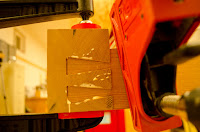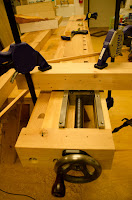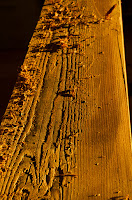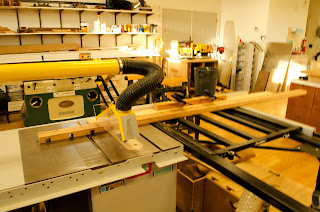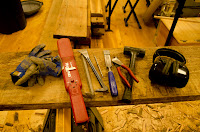The first up was laying out the mortises for the top to land on to the base. Again, the Sketch Up model that Aaron Marshall did for Guild was open and constantly referenced. Using Aaron's model has convinced me that Sketch Up is a must for me to learn. Any questions I've had during this build have been easy to answer by referencing the exploded views. I am always tailoring some of the measurements due to my bench being both 10 feet long and only having a 3 inch laminate top.
I had been planning on routing the mortises, but wasn't really looking forward to it because of all the dust it would be creating. More on dust later. Through discussion on Twitter and an earlier recommendation by Rob Bois of The Bois Shop (A VERY excellent podcaster), I decided to buy the Triton 2 1/4 HP plunge router. While, according to all the input, the Triton did not have the 5 star rating of the Festool routers, it did have really good dust collection and at a much lower price point. Luckily, Milne Power Tools, which is conveniently right across the street from my office, carries the Triton brand. When I got the router home, I made a few modifications with foam tape to help the dust collection to be a bit more effective and set up what I like to call my white trash boom arm.
This allowed me to route without dealing with the weight of the vacuum hose, which I fed over the top of the only interior wall and suspended with a rope. If I had only had some baling wire!
 Once the mortises were cut, I set up the Excalibur sliding table with the miter fence and cut the legs to length and also cut the tenons.
Once the mortises were cut, I set up the Excalibur sliding table with the miter fence and cut the legs to length and also cut the tenons. I'm essentially a lazy person, so I just nibbled the material away rather than deal with changing out my everyday blade with the dado set. It really didn't take up any time and the cheeks cleaned up quickly with my 2 inch chisel.
I spent quite a while perfecting the fit of the legs to the top, but I'm finding more and more I actually love hand work. I can lose all track of time while I'm playing with a sharp blade on wood. The size of these tenons was a real joy to work with the 2 inch chisel. The angle is set rather shallow to be a really great paring blade.

Once I was happy with the fit of the legs to the top, I stopped and milled all the stretcher parts. This is a process that I forgot to document. I still use, and sure I always will, power tools for any of the processes that would be labor intensive with hand tools.
Since I plan to first assemble the ends, I made sure the legs were dead square and marked the shoulders of the tenons. I then laid out the mortise on the legs that will house the stretchers. Again, I extensively used Aaron's Sketch Up model.
The next part, which I know some are interested in, was again missed in photo documentation. The Woodrat, a machine that I really love, is also a machine I really hate. I have not come up with a good solution for dust collection while using it. I couldn't cut the tenons with the Triton because they were too deep for the Triton plunge capacity. The Woodrat really excels at rather quickly cutting mortises, although I don't have mine set up to easily handle this size of timber. You can get a pretty good overview of what the Woodrat is capable of on the Woodrat Site. I don't remember the name of the guy, but before he died, he reviewed tools and showed how to use them in great detail. He always had some young lady helping him out. If you remember his name, please post it in the comments.
Tonight I finished up the mortises and will start the stretchers tomorrow. If there are any processes you have a question about or frankly advise on a better way to do a process, please let me know in the comments.














